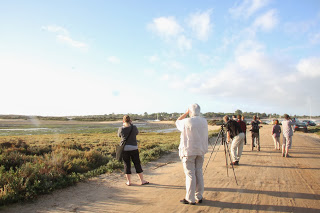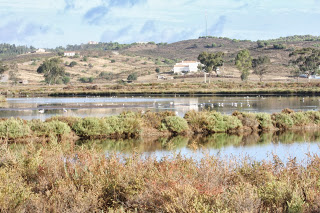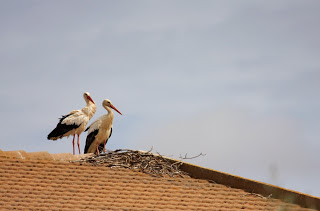The
night trip I talked about previously was only one part of The Sagres Birdwatching Festival. The Sagres Peninsula was the
venue for the festival on the 4th to 6th October 2013. It is the only site in
Portugal where the autumn migration of soaring birds can be observed.
The
festival is the biggest birdwatching event in Portugal and plays host to a
variety of different events and activities, all themed around the enjoyment of
nature. Activities such as boat trips, scuba diving, horse riding, birdwatching
trips, moth/ plant/ fungi courses, astronomical observations, bird ringing,
nest box building, lectures, photography lessons, mountain bike riding and
more are all on offer!
The festival is organised by SPEA (BirdLife in Portugal) along with Almargem and is part of the rural development project ‘Um Outro Algrave’ (Another Algarve).
The boat
trip I went on was highly enjoyable – after the initial disconcertion of going on a pelagic in what looked like a
banana boat! It was a little windy when we were out so the bird watching didn’t
go all that well, but views of Common Dolphin, Hammerhead Shark, Balearic and
Cory’s Shearwater, lots of gulls and a Gannet diving near us made up for it!
Not
only was the festival a great way for adults and children to interact with nature, but it’s also promoted the work of
conservation organisations like SPEA.
A trip to Monte de Cabranosa provided superb views of soaring birds. But is also a bird monitoring session that the public can get involved in.
The
soaring birds spot provided great views of raptors such as Short-toed Eagle,
Booted Eagle, Black Kite, Hobby, Sparrowhawk plus lots of other birds including
storks, a scorpion and a Swallow-tailed Butterfly that had me running along the
ridge trying to get a picture…
A
gorgeous Booted Eagle
Black
Stork flying over Cabranosa
This
scorpion was really amazing!
This
butterfly had me running past birdwatchers looking up to try and get a picture
– not the best of pictures but I’m happy!
Lagoa dos Salgados is a coastal lagoon that has been
formed by the confluence of two rivers. The area is very urban and surrounded
by a golf course and hotels, but yet provides a fantastic wildlife refuge.
It
would have been great to explore the reserve fully but from our short walk we
still saw Glossy Ibis, a melanistic Montagu’s Harrier and a really interesting looking locust.
If I
thought wandering around the golf course at Ria Formosa was odd, visiting the Vilamoura Reedbeds topped it… Standing, or in my case falling over, on a
slope amongst the trees, overlooking a large water treatment works full of
birds and plastic islands did feel odd, but it was stunning for wildlife!
Black-necked
Grebe, Red-crested Pochard, and Black-winged Kite were my favourite sightings.
Our
last birding spot was the Foz do
Almargem, a small costal lagoon with waders and loads of gulls including
Audouin’s and Yellow-legged Gulls. It is a great place to wander round to look for wildlife.
All in
all I had a wonderful visit to the Algarve. It’s a nice place to visit. The
people are wonderful, the food is great and the birding is easy.
For
me, if I return it would be an indication of how good a place has been – and
yes, I would love to return to Portugal and explore it fully.
I
would like to say a big thank you to my new friends, all of our guides, Ana
Vargues and everyone at the Algarve Promotion Bureau for all the hard work
organising this fantastic trip.
For more information on the Algarve visit: www.visitalgarve.pt
and www.algarvepromotion.pt


















































































